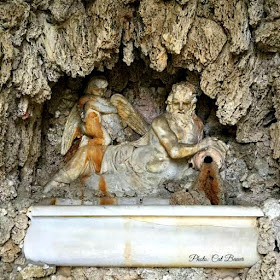 |
| Roof Terrace at the Peggy Guggenheim Collection - Photo: Cat Bauer |
When the weather is fine, one of the most beautiful spots for a press conference in Venice is on the roof terrace of Palazzo Venier dei Leoni, once home to Peggy Guggenheim, and now home to her collection of modern art. That is where Luca Massimo Barberto, curator of IMAGINE, presented the Guggenheim's latest exhibition to the press.
 |
| Drive-In House by Fabio Mauri (1960) |
In Italy, the 60s were a time of the "boom," when the country transformed into an industrial power, and the art and culture scene radically shifted to reflect the changing times. Without categorizing the period into labels or movements, the exhibition presents a highly selective sampling of Italian artists working during this critical time.
 |
| Papal Crest by Franco Angeli (1964) |
 |
| Venus, after Botticelli by Giosetta Fioroni (1965) |
 |
| Body in Motion by Mario Schifano (1963) |
In the early 60s, Schifano got a studio at 791 Broadway where Jasper Johns and the poet Frank O'Hara also lived. He caroused through the city with O'Hara. One of the results: Words and Drawings, words from the poet and drawings from the artist in a portfolio.
Schifano was part of the groundbreaking International Exhibition of the New Realists show organized by Sidney Janis in 1962, together with such artists as Lichtenstein, Warhol, Oldenburg and Jasper Johns.
 |
| Red Dress Collar by Domenico Gnoli (1969) |
"I like America, but my ties are all to Italy. I am metaphysical insofar as I seek painting which is non-eloquent, still and atmospheric, fulled by static sensations. I am not metaphysical because I have never sought to stage, to construct an image. I always use simple and given elements, I want neither to add nor subtract anything. I have never even wanted to distort: I isolate and I represent. My themes are derived from actuality, from the familiar situations of daily life; since I never intervene actively against the object, I can sense the magic of its presence."
 |
| Self-portrait by Giulio Paolini (1968) |
 |
| Burnt Rose by Michelangelo Pistoletto (1965) |
IMAGINE. NEW IMAGERY IN ITALIAN ART 1960-1969 runs through September 19, 2016 at the Peggy Guggenheim Collection.
Images courtesy the Peggy Guggenheim Collection.
Ciao from Venezia,
Cat Bauer
Venetian Cat - The Venice Blog






















